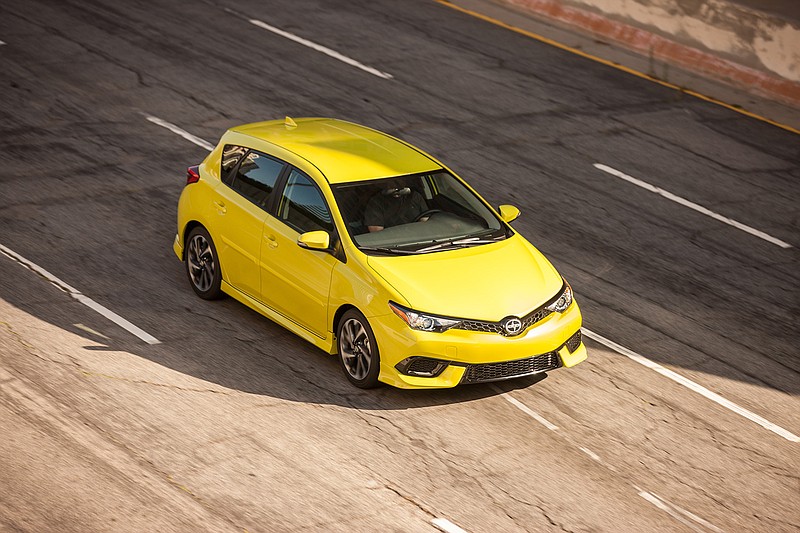Rolling down a back highway through the Arkansas hills, the sweeping esses looked inviting, a gentle turn and slight dip to the right, a sharp rising left to exit.
The Scion iM felt like a car that might be able to straighten those turns-a light, nicely balanced chassis, dull but decent steering feedback, strong brakes and, if I got into trouble, slightly intrusive traction control.
Torque, I believe, is the key to hard cornering. It's the force that overcomes the car's inertia (which wants to keep the mass going in whatever direction it's heading, and centrifugal force (generated when that mass is redirected).
Heading across the apex of a curve, torque is your friend. It tells the other two, "Hush now, we're not going to fly off the edge of the earth because I'm going to pull us through this."
Peak horsepower is usually found in the upper quartile of engine's RPM band, and torque lives just a little lower, somewhere around 65-85 percent of a gas engine's peak revs. Either way, to push handling limits, calls for RPM somewhere between midway and redline
So I started to downshift to grab some rev. Sixth to fifth, no problem, not much change.Quickly into fourth-no, wait, is that fourth or second? Can't tell and can't let out the clutch because, at this speed, if I am in second, the engine will over-rev-okay, go to third, that's a primary cornering gear. No, wait, is that third or fifth? Release the clutch and see. Arrgh! It's fifth!
The transmission's ratios feel perfect for spirited driving, but a sloppy shifter and poorly placed clutch contact point make getting to them in a hurry downright impossible.
I slowed the car and trundled through the switchback like grandma-not grandpa, where do you think I learned to drive like a bat out of ?-rolling out her tea cart.
In that moment, I understood why Toyota is shuttering Scion.
For a decade or so, auto marketers faced a conundrum: Millennials, the emerging demographic, didn't want to buy cars. The Boomers' kids are perennially slow to all of life's coming-of-age benchmarks: leaving home, marrying, starting families. So signing a 48- or 60-month note to buy something that they don't necessarily covet just wasn't high on their list.
So in 2003, Toyota decided to give them their own car company. The concept was simple: Basic cars, strong on technology and reliability, high level of features at an affordable base level, plenty of passenger room (in those days, millennials did everything with friends).
The purchasing experience was straightforward: design-it-on-line, no-haggle purchasing. Pick you car, pick your options, put down your money and go to the dealer and pick it up.
Sounded great, and I was one of biggest fans of the idea, which, as it turned out, didn't go over all that well. I get that, I had a hand in trying to raise a few millennials. Had a lot of great ideas that I proposed and the rolling eyes disposed.Ten years ago, millennials didn't want to buy new cars. Now, they've finally started families and, as it turns out, their college educations are giving them some real buying power and they don't want small, specialized cars. They want family-sized SUVs and sedans. They don't want an iA or a TC. They want a Highlander or a Malibu.
Who'da thunk?
So why run two companies when one will do? 86 Scion.
Toyota sought, and probably got, with its reliability and first-rate dealer experience, some brand loyalty with the Scion experiment. The opportunity it missed was to build some real fervor by making the Scion special. The old saying is that anybody can get a car 98 percent right, but it takes a genius to dial in that last two percent. Scions never showed the fingerprints of the two percenters.
Case in point, the iM.
Don't get me wrong, there's nothing wrong with this car, a rebadged Toyota Auris, a top seller in Europe, Japan and Australia, often with a diesel power plant. As Scion goes away, the iM will probably work its way into U.S. showrooms as a high-value flavor of the Toyota Corolla because it is a solid, if not particularly exciting, compact hatchback.
Starting around $19,000, this particular market niche is crawling with first-rate competitors: The Ford Focus, Kia Forte, Mazda3, VW Golf and the head of the class, the all-new Honda Civic, a superb combination of agility, comfort, space, fuel economy, and technology. If zoom-zoom driving is your style, the Mazda3 has a crisp gear box and taut suspension and the Golf just feels like it's built to go racing.
The iM competes well because it's a superb daily commuter, with a comfortable ride and a full list of standard features, including a 7-inch touch screen in the dashboard, a 4.2-inch color display in the gauge cluster, a rear-view camera, dual-zone automatic climate control, a six-speaker Pioneer stereo, an auxiliary audio input, HD Radio, Bluetooth, a USB port and Aha, which provides access to Facebook, Twitter and Internet radio stations.
For a list price of $19,609, delivery included, that's a lot of car for the money.
The infotainment system connected immediately with my phone, as well as with my iPod. The Pioneer sound system has great frequency response and the touch screen is easy to use. Leather seating and a moon roof are not available, but my humble opinion is that both are overrated.
We took our tester on a couple of road trips and it proved to be an amicable companion, delivering around 31 mpg in combined driving, giving it a range of more than 420 miles on its 14-gallon tank.
The iM rolls on a four-wheel independent suspension system. In the balance between performance and comfort, Scion dialed in some of the former and, for the market niche, a heaping helping of comfort. Rolling down the interstate, this car gobbles up the miles while sipping gas.
Though European versions come with two gas and one diesel engine choice, the stateside version comes with one power plant, a 1.8-liter I-4 from the Toyota Corolla Eco but tuned to 137 hp with 126 lb-ft of torque. A six-speed manual is standard, a continuously-variable automatic, with a button to push to make it feel you're shifting a seven-speed, adds about $600.
Bottom Line: The iM is a solid little car. Heck, it's about 98 percent perfect. If Toyota would only do something about that gearbox.


